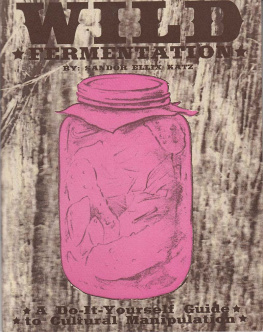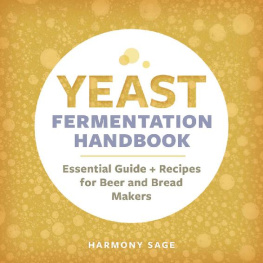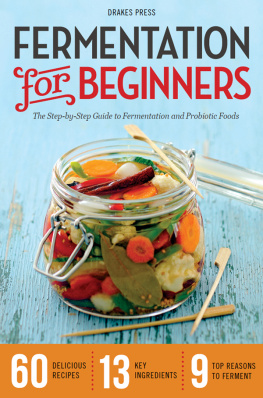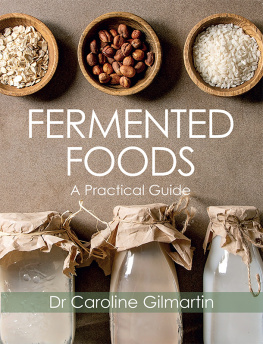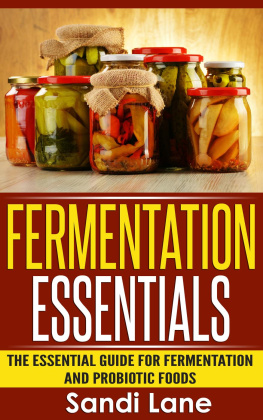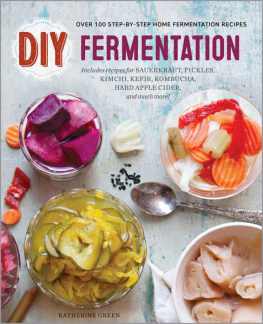Table of Contents
Praise for Wild Fermentation
While the recipes are plentiful the authors writing is what pulled me in and captivated me. He is very knowledgeable on the subject of fermented foods and examines them through a historical, scientific, and even a philosophical sense.... As I type these words there are crocks of sauerkraut and bread starter bubbling away on my kitchen counter, and after reading Wild Fermentation I not only appreciate but also understand the life cycles of each.
Cheftalk.com
For those of us raised to believe that cleanliness is Godliness and sterilization the route to health, the notion that wed sometimes be better off letting microbes have their way in our food seems... well, wild. Armed with nothing more than a taste for sour flavors, and a decade of experiment that began with salted cabbage, Katz takes the reader on a tour of praise for what microbial biodiversity can do for foods and human health. A witty and enlightening romp with mix, wait, and check recipes for everything from brined garlic to vineagre de pina.
Joan Gussow, author, This Organic Life
Katzs desire to help others learn the craft of fermentation shines throughout this book.
Northeast Food System Partnership
A gold mine for science-fair projects.
Booklist
Yes, this is a good book for anyone who wants to know how to make kraut or kimchi or goat cheese, but it is also a book for anyone who wants to know about life, about how life workshow to enjoy it, respect it, love it and eat it.
Indy Media Center
A unique cookbook for gardeners.... This book will appeal to those interested in world food traditions, the history of human nutrition, and the whys of good food and good health.
The Washington Post
Katz has obviously done comprehensive research on his subject and is passionate about it.
Library Journal
Comprehensive.... Delves into the how, when, why, and where of this delicious process with joyfully obsessive abandon.
Kitchen and Cook (the newsletter of the Culinary Institute of America)
Sandor Ellix Katz delves deep into the magic and meaning of food with Wild Fermentation .
Body and Soul Magazine
Copyright 2003 Sandor Ellix Katz.
Illustrations copyright 2003 Robin Wimbiscus.
No part of this book may be transmitted in any form by any means without permission in writing from the publisher.
Designed by Jill Shaffer.
Printed in the United States
First printing, July, 2003
08 07 06 4 5 6
Recycled Paper
Chelsea Green sees publishing as a tool for cultural change and ecological stewardship. We strive to align our book manufacturing practices with our editorial mission, and to reduce the impact of our business enterprise on the environment. We print our books and catalogs on chlorine-free recycled paper, using soy-based inks, whenever possible. Chelsea Green is a member of the Green Press Initiative (www.greenpressinitiative.org), a nonprofit coalition of publishers, manufacturers, and authors working to protect the worlds endangered forests and conserve natural resources. Wild Fermentation was printed on Domtar Colors Cream, a 30 percent post-consumer waste paper.
Library of Congress Cataloging-in-Publication Data
Katz, Sandor Ellix, 1962-
Wild fermentation : the flavor, nutrition, and craft of live-culture foods / Sandor Ellix Katz.
p. cm.
Includes bibliographical references and index.
ISBN 1-931498-23-7 (alk. paper)
1. Fermented foods. I. Title. TP371.44.K37 2003 641.7dc21
2003046207
Chelsea Green Publishing Company
P.O. Box 428
White River Junction, Vermont 05001
800-639-4099
www.chelseagreen.com
DEDICATED TO JON GREENBERG (1956-1993)
This beloved ACT UP comrade first articulated to me the idea of peaceful coexistence with microbes rather than warfare. I honor Jon and all our fellow skeptics, rebels, and iconoclasts who question prevailing wisdom and authority. Believe in the future and keep change fermenting.
FOREWORD
by Sally Fallon
THE PROCESS of fermenting foodsto preserve them and to make them more digestible and more nutritiousis as old as humanity. From the Tropicswhere cassava is thrown into a hole in the ground to allow it to soften and sweetento the Arcticwhere fish are customarily eaten rotten to the consistency of ice creamfermented foods are valued for their health-giving properties and for their complex tastes.
Unfortunately, fermented foods have largely disappeared from the Western diet, much to the detriment of our health and economy. Fermented foods are a powerful aid to digestion and a protection against disease. And because fermentation is, by nature, an artisanal process, the disappearance of fermented foods has hastened the centralization and industrialization of our food supply, to the detriment of small farms and local economies.
The taste for fermented foods is usually an acquired taste. Few of us can imagine eating fermented tofu crawling with worms, which is relished in parts of Japan; or bubbly sorghum beer, smelling like the contents of your stomach, which is downed by the gallons in parts of Africa. But then, few Africans or Asians can enjoy the odiferous chunks of rotten milk (called cheese) that are so pleasing to Western palates. To those who have grown up with fermented foods, they offer the most sublime of eating experiencesand there are many that will appeal to Western tastes even without a long period of accustomization.
In the spirit of the great reformers and artists, Sandor Katz has labored mightily to deliver this magnum opus to a population hungry for a reconnection to real food and to the process of life itself. For fermented foods are not only satisfying to eat, they are also immensely satisfying to prepare. From the first successful batch of kombucha to that thrilling taste of homemade sauerkraut, the practice of fermentation is one of partnership with microscopic life. This partnership leads to a reverence for all the processes that contribute to the well-being of the human race, from the production of enzymes by invisible bacteria to the gift of milk and meat from the sacred cow.
The science and art of fermentation is, in fact, the basis of human culture: without culturing, there is no culture. Nations that still consume cultured foods, such as France with its wine and cheese, and Japan with its pickles and miso, are recognized as nations that have culture. Culture begins at the farm, not in the opera house, and binds a people to a land and its artisans. Many commentators have observed that America is a nation lacking culturehow can we be cultured when we eat only food that has been canned, pasteurized, and embalmed? How ironic that the road to culture in our germophobic technological society requires, first and foremost, that we enter into an alchemical relationship with bacteria and fungi, and that we bring to our tables foods and beverages prepared by the magicians, not machines.
Wild Fermentation represents not only an effort to bring back from oblivion these treasured processes but also a road map to a better world, a world of healthy people and equitable economies, a world that especially values those iconoclastic, free-thinking individualsso often labeled misfitsuniquely qualified to perform the alchemy of fermented foods.
ACKNOWLEDGMENTS
THIS PROJECT has given my life focus and meaning at a time when I desperately needed these things. I spent 1999 and 2000 in the abyss of AIDS, accepting the idea that death could be near, living in the moment as much as possible, and trying not to dwell on a future that appeared dim. My deepest gratitude is for being alive and healthy. This project has given me back a sense of the future as expansive and full of possibilities.



